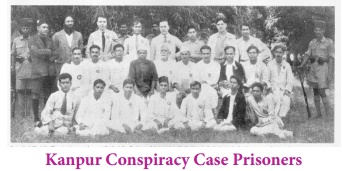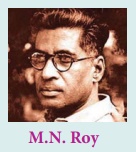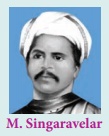Period of Radicalism in Anti-imperialist Struggles | History - Kanpur Conspiracy Case, 1924 | 12th History : Chapter 5 : Period of Radicalism in Anti-imperialist Struggles
Chapter: 12th History : Chapter 5 : Period of Radicalism in Anti-imperialist Struggles
Kanpur Conspiracy Case, 1924
Kanpur Conspiracy Case, 1924

The
colonial administrators did not take the spread of communist ideas lightly.
Radicalism spread across the British Provinces – Bombay, Calcutta and Madras -
and industrial centres like Kanpur in United Province (UP) and cities like
Lahore where factories had come up quite early. As a result, trade unions
emerged in the jute and cotton textile industries, the railway companies across
the country and among workers in the various municipal bodies. In order to curb
the radicalisation of politics, especially to check what was then called
Bolshevism, repressive measures were adopted by the British administration. The
Kanpur Conspiracy case of 1924 was one such move. Those charged with the
conspiracy were communists and trade unionists.
The
accused were arrested spread over a period of six months. Eight of them were
charged under Section 121-A of the Indian Penal Code – ‘to deprive the King
Emperor of his sovereignty of British India, by complete separation of India
from imperialistic Britain by a violent revolution’, and sent to various jails.
The case came before Sessions Judge H.E. Holmes who had earned notoriety while
serving as Sessions Judge of Gorakhpur for awarding death sentence to 172
peasants for their involvement in the Chauri Chaura case.
In the
Kanpur Conspiracy case, Muzaffar Ahmed, Shaukat Usmani, Nalini Gupta and S. A.
Dange were sent to jail, for four years of rigorous imprisonment. The trial and
the imprisonment, meanwhile, led to some awareness about the communist
activities in India. A Communist Defence Committee was formed in British India to
raise funds and engage lawyers for the defence of the accused. Apart from
these, the native press in India reported the court proceedings extensively.

13 persons were originally accusedintheKanpurcase: M.N. Roy, (2)
Muzaffar Ahmad, (3) Shaukat Usmani, (4) Ghulam Hussain, (5) S.A. Dange, (6) M. Singaravelar,
R.L. Sharma, (8) Nalini Gupta, Shamuddin Hassan, (10) M.R.S Velayudhun, (11)
Doctor Manilal, Sampurnananda, (13) Satyabhakta. 8 persons were charge-sheeted:
M.N. Roy, Muzaffar Ahmad, S.A. Dange, Nalini Gupta, Ghulam Hussain,
Singaravelar, Shaukat Usmani, and R.L. Sharma. Ghulam Hussain turned an
approver. M.N. Roy and R.L. Sharma were charged in absentia as they were in
Germany and Pondicherry (a French Territory) respectively. Singaravelar was
released on bail due to his ill health. Finally the list got reduced to four.
The trial
in the conspiracy case and the imprisonment of some of the leaders, rather than
kill the spirit of the radicals gave a fillip to communist activities. In
December 1925, a Communist Conference of different communist groups, from all
over India, was held.Singaravelar from Tamil Nadu took part in this conference.
It was from there that the Communist Party of India was established, formally,
with Bombay as its Headquarters.

M. Singaravelar (18 February 1860 – 11 February 1946), was born
in Madras. He was an early Buddhist, and like many other communist leaders, he
was also associated with Indian National Congress initially. However, after
sometime he chose a radical path. Along with Thiru. V. Kalyanasundaram, he
organised many trade unions in South India. On 1 May 1923, he organised the
first ever celebration of May Day in the country. He was one of the main
organisers of the strike in South Indian Railways (Golden Rock,
Tiruchirappalli) in 1928 and was prosecuted for that.
Related Topics